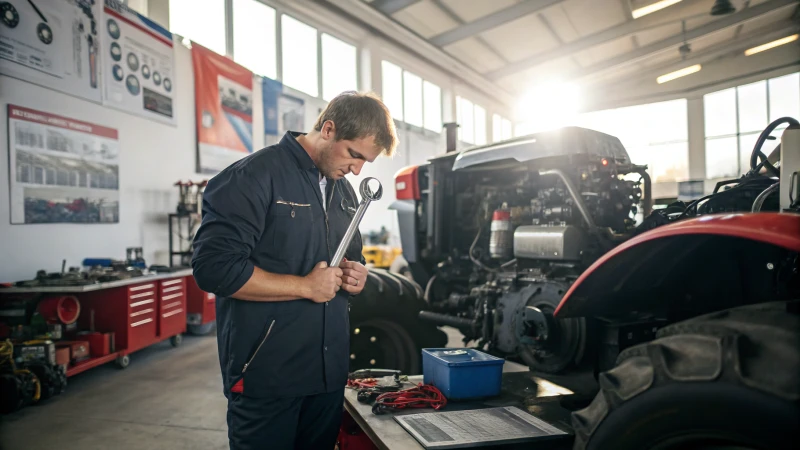Have you ever found yourself mid-harvest with a tractor that just won’t start?
To create an effective farm tractor maintenance schedule, I start by breaking down tasks into daily, weekly, monthly, and annual routines. This includes regular checks on oil, fluids, tires, and key components to ensure optimal performance and extend the tractor's lifespan.
I remember the frustration of losing precious hours because I hadn’t checked the oil or tire pressure. That’s why I realized the importance of a tailored maintenance schedule. With each tractor having its quirks, understanding your specific model's needs can save you both time and money. Let’s explore how to make your maintenance routine truly effective.
Daily checks on oil and fluids extend tractor lifespan.True
Regular maintenance prevents wear and tear, prolonging equipment life.
Annual maintenance is sufficient for farm tractors.False
More frequent checks are necessary to ensure optimal performance.
What Are the Daily Maintenance Tasks for Farm Tractors?
Every morning on the farm, my tractor is like a trusty old friend that needs a little TLC to get going.
Daily maintenance for farm tractors involves checking engine oil, hydraulic fluids, coolant levels, tire condition, and lights. A visual inspection for leaks or damage is crucial too. These tasks ensure smooth operations and longevity of your equipment.

Engine and Fluid Checks
I start my day by popping open the hood to check the engine oil. It's a small ritual that gives me peace of mind, knowing I'm preventing unnecessary wear on my trusty tractor. With a quick swipe of the dipstick, I can tell if it's time to top off the oil. Then, it's on to the hydraulic fluids. These are the unsung heroes behind every seamless attachment operation. I’ve learned the hard way that low hydraulic fluid can spell disaster during a busy harvest season.
| Fluid | Check | Action |
|---|---|---|
| Engine Oil | Dipstick | Add if low |
| Hydraulic Fluid | Reservoir | Top up |
Tire and Light Inspections
Tires might seem straightforward, but they hold the weight of everything we do. I remember that one time I ignored a worn tire, and it gave out right in the middle of plowing—a lesson learned! Every morning, I make sure to check for any cuts or punctures and ensure the pressure is just right. Afterward, I take a quick walk around to check all lights and signals. It’s not just about me; it’s about safety on the farm.
- Tire Inspection: Visual check for cuts or punctures.
- Tire Pressure: Use a gauge for accuracy.
- Lights: Turn on and off each light to ensure functionality.
Visual Inspections for Damage
The final step in my morning routine is a thorough look-over of the tractor. I check under the chassis for oil leaks—it’s surprising how easy it is to miss them until they become a big problem. Belts and hoses also get my attention; after all, a small crack today can become tomorrow’s breakdown. Trust me, catching these early saves not just money, but precious time.
- Oil Leaks: Check beneath tractor.
- Belts/Hoses: Look for cracks or fraying.
Building these checks into my daily routine has been a game-changer. It’s like giving my tractor a daily health check-up, keeping it running smoothly and saving me from costly surprises later on. If you're new to this or need a detailed checklist, there are plenty of resources online1 to help you get started.
Daily checks prevent costly tractor repairs.True
Regular inspections catch issues early, reducing repair costs.
Tire pressure doesn't affect fuel efficiency.False
Proper tire inflation improves stability and fuel efficiency.
How Often Should You Perform Weekly Tractor Maintenance?
Keeping my tractor humming like a well-tuned engine doesn't just happen by chance; it takes consistent care. But how often should those weekly check-ups be? Let's delve into the essentials of tractor maintenance.
Weekly tractor maintenance is best performed every 50-60 hours of use. This involves checking tire pressure, greasing fittings, tightening loose bolts, and cleaning the radiator screen to ensure top-notch performance and extend your tractor's life.

Importance of Regular Maintenance
I learned the hard way that ignoring regular maintenance could lead to some hefty repair bills. Once, I skipped a few weeks, and before I knew it, a minor bolt issue turned into major downtime. That’s when I realized: consistent maintenance isn't just a chore; it's a money-saver and keeps my tractor ready for action.
Key Weekly Maintenance Tasks
Here's a table outlining essential tasks to include in your weekly maintenance routine:
| Task | Description |
|---|---|
| Check Tire Pressure | Ensures safe operation and fuel efficiency. |
| Grease All Fittings | Reduces wear and prevents rust. |
| Tighten Loose Bolts | Prevents parts from detaching during use. |
| Clean Radiator Screen | Avoids overheating by ensuring airflow. |
Frequency Considerations
When I first started maintaining my tractors, I thought once a week was enough, but I quickly learned the frequency depends on several factors:
- Operating Hours: Generally, perform these checks every 50-60 hours of operation.
- Environment: Working in dusty fields means more frequent clean-ups.
- Manufacturer's Guidelines: My manual is my bible—always refer to it for specifics.
Tools and Supplies Needed
Before starting, I make sure my toolbox is ready:
- Tire gauge for pressure checks
- Grease gun for lubricating fittings
- Wrench set for tightening bolts
- Soft brush or air compressor to clean the radiator screen
Practical Tips for Effective Maintenance
- Record Keeping: I maintain a maintenance log2 religiously. It helps me track what’s done and what's due.
- Professional Assistance: When something's beyond my skill set, I don't hesitate to call in the pros.
- DIY vs. Professional Service: Evaluate whether tasks can be done yourself or if they require professional expertise3.
By weaving these habits into my routine, I keep my tractor not only efficient but also safe. These simple steps have saved me countless hours and dollars, ensuring my equipment is always ready for the next big job.
Weekly maintenance prevents costly repairs.True
Regular checks catch minor issues early, avoiding expensive fixes.
Tractors need maintenance every 100 hours of use.False
Maintenance is recommended every 50-60 hours for optimal performance.
What Monthly Checks Are Essential for Tractor Longevity?
When I first got my hands on a tractor, I had no idea how crucial monthly maintenance was until a costly breakdown caught me off guard.
To keep your tractor running smoothly and efficiently, make sure to perform essential monthly checks such as changing engine oil, inspecting air filters, checking belts and hoses, and evaluating brake performance. These tasks help extend the lifespan of your equipment and prevent unexpected breakdowns.

Change Engine Oil and Replace Oil Filter
I remember the first time I learned about changing engine oil—it was after an unfortunate incident where my tractor's engine started making strange noises. Since then, I've made it a priority to change the engine oil4 every month. Fresh oil ensures everything runs smoothly and prevents those nasty surprises. And don't forget to replace the oil filter while you're at it; it's a small step that makes a big difference.
Inspect and Clean Air Filter
You wouldn't believe the amount of dust and debris that can clog up your air filter, especially if you're working in dusty conditions like I often do. A clean air filter is crucial for maintaining fuel efficiency and engine performance. So, I make it a point to inspect and clean mine every month—sometimes even more frequently if I'm tackling particularly dusty fields.
| Task | Action |
|---|---|
| Air Filter Inspection | Check for debris |
| Air Filter Cleaning | Use compressed air |
Check Belts and Hoses for Wear
Once, during a busy harvest season, I ignored a cracked belt—and let's just say, I paid the price with downtime I couldn't afford. Now, I diligently check all belts and hoses for wear every month. It's much easier to replace them before they cause a breakdown.
Examine Brake Performance
Safety first—that's something I can't stress enough. Regularly checking brake performance, including pads and fluids, keeps my tractor safe to operate. Monthly checks help me feel confident that I can stop reliably when needed.
Additional Considerations
- Battery Maintenance: I learned the hard way that corroded terminals can mess with your battery's performance. Cleaning them monthly helps avoid surprises.
- Tire Inspection: Don't overlook tire pressure and tread depth; they impact everything from fuel efficiency to safety.
- Visual Inspection: A quick walk-around to check for leaks or unusual signs can prevent bigger issues down the line.
I highly recommend exploring more resources5 for deeper insights into maintaining tractor efficiency. These checks not only prolong your tractor's life but also improve farm productivity6. Keeping a monthly maintenance checklist7 has been a lifesaver for me, ensuring I never miss a task. Plus, tracking maintenance activities in a log is incredibly useful for spotting trends and planning ahead.
Changing engine oil monthly extends tractor lifespan.True
Regular oil changes reduce engine wear, preventing damage and ensuring longevity.
Monthly brake checks are unnecessary for tractors.False
Brake efficiency is crucial for safety; monthly checks ensure reliability.
When Should I Perform Quarterly Tractor Maintenance?
Keeping my tractor in top shape is like having a reliable partner in the field. It’s all about timing and care.
Quarterly tractor maintenance, ideally every 500 hours, is vital to keep everything running smoothly. This routine involves changing oils, swapping out filters, and tweaking essential components to prevent breakdowns and extend your tractor's life.

Understanding the Importance of Quarterly Maintenance
I've learned that sticking to a quarterly maintenance8 schedule can save me from a lot of headaches down the road. After about 500 hours of use, it's time to give my trusty tractor some TLC. This regular check-up isn't just about preventing breakdowns—it's about ensuring that everything runs as efficiently as possible.
Key Components to Inspect
- Fuel Filter Replacement:
- I once ignored this, and boy, did my engine let me know! It's crucial for keeping clogs at bay.
- Hydraulic Oil Change:
- Nothing worse than a sluggish hydraulic system when I'm in the middle of a job.
- Clutch Adjustment:
- A slipping clutch can really mess with control, so keeping it tight is key.
Detailed Maintenance Schedule
| Task | Description |
|---|---|
| Fuel Filter Replacement | Avoids clogs and maintains fuel efficiency. |
| Hydraulic Oil Change | Prevents hydraulic failures. |
| Clutch Adjustment | Ensures smooth operation and control. |
| Valve Clearance Check | Optimizes engine performance. |
| Wheel Bearings Lubrication | Reduces wear and increases wheel lifespan. |
Best Practices for Maintenance
- Record Keeping:
- I keep a detailed log of every maintenance activity. It helps me anticipate future needs and spot trends.
- Manufacturer's Guidelines:
- I always refer back to the manufacturer's recommendations9 specific to my tractor model. It’s like having a cheat sheet for maintenance.
- Professional Servicing:
- Sometimes, I call in the pros for the trickier tasks. It's worth it to avoid costly mistakes.
Regular maintenance doesn't just improve performance—it enhances tractor safety10 by ensuring every part is in tip-top shape.
Quarterly maintenance is needed every 500 hours of use.True
The context specifies that maintenance should be done after 500 hours.
Fuel filter replacement is optional during quarterly maintenance.False
Fuel filter replacement is essential to avoid clogs and maintain efficiency.
What Annual Maintenance Tasks Keep Tractors Running Smoothly?
Ever wonder what it takes to keep a tractor humming along like a well-oiled machine year after year?
Annual tractor maintenance involves tasks like changing transmission fluid, replacing air filters, inspecting the fuel injection system, and checking wheel alignment. These steps ensure your tractor remains reliable and long-lasting.

Transmission Fluid Change
Changing the transmission fluid is like giving your tractor a fresh start each year. I remember the first time I did this—it was a mess! But once I got the hang of it, I noticed fewer issues with gear slippage11. It's like giving your tractor a tune-up and watching it perform like new.
| Task | Recommended Interval |
|---|---|
| Change Transmission Fluid | Annually |
Air Filter Replacement
There's nothing worse than realizing your tractor is guzzling fuel like there's no tomorrow. That happened to me until I figured out that a clogged air filter was the culprit. Now, replacing the air filter annually is a non-negotiable task on my list. Trust me, it makes a world of difference in efficiency.
Inspecting the Fuel Injection System
Ah, the fuel injection system—it's like the heart of your tractor. I always make sure to have it checked annually. Once, a tiny clog almost left me stranded in the middle of a field. Ever since, I don't take chances and get it inspected regularly for leaks or clogging12. If you're unsure about this, professional help can be a lifesaver.
- Tip: Use professional services if unsure about system assessments.
Wheel Alignment Check
Misaligned wheels can feel like you're wrestling with your tractor rather than driving it. After experiencing uneven tire wear and less-than-stellar handling, I've learned to check wheel alignment religiously. It saves on fuel and gives you peace of mind with regular checks13.
Cooling System Flush
A cooling system flush might sound technical, but think of it as spring cleaning for your engine. One year, ignoring this led to overheating issues that were an absolute nightmare. Now, I ensure the cooling system gets flushed annually, using only manufacturer-recommended coolants.
Keeping a record of all these tasks is crucial. There was one season where I couldn't remember what I'd done the previous year, which led to unnecessary repairs. Now, maintaining a well-documented maintenance schedule helps track service history and detect recurring issues early—my best friend in keeping my tractor running smoothly year after year.
Changing transmission fluid prevents gear slippage.True
Regular fluid changes maintain optimal lubrication, preventing slippage.
Skipping air filter replacement reduces fuel efficiency.True
A clogged filter restricts airflow, increasing fuel consumption.
How Can You Customize Maintenance Schedules for Different Tractor Models?
Ever tried juggling a dozen balls while riding a tractor? That's what it feels like managing different maintenance schedules for various models! Let's make it simpler.
To customize maintenance schedules for different tractor models, I always start by diving into the manufacturer's manual for each model. It's like my tractor bible. From there, I tailor daily, weekly, monthly, and annual tasks to fit each model's quirks and how hard I work them.

Understand Model-Specific Needs
Each tractor model is like a character in its own right, with its quirks and needs. I’ve learned to treat the manufacturer's manual as my go-to guidebook. It spells out everything from when to change the oil to what parts might need replacing down the line. It’s the roadmap to keeping my tractors in tip-top shape.
Create a Detailed Maintenance Log
When I first started, I’d lose track of what needed doing and when—until I created a maintenance log. Now, I jot down everything in a table format:
| Date | Task | Parts Checked | Notes |
|---|---|---|---|
| 01/01 | Oil Change | Engine Oil Filter | Done |
This system keeps me organized and ensures nothing slips through the cracks.
Customize According to Usage
I realized that not every tractor gets the same workout. Some are like marathon runners, needing more frequent checks, while others are more like sprinters. For high-usage models, daily checks are essential, but those used less often might only need weekly attention.
- Daily Checks: Ideal for tractors that are put through their paces every day.
- Weekly Checks: Fit for those that enjoy a lighter workload.
Leverage Technology
I’m not exactly a tech guru, but I’ve found some great apps that remind me about upcoming maintenance tasks. They’re like having an assistant who doesn’t mind reminding me repeatedly! These tools let me customize alerts for each model using software solutions14.
Incorporate Expert Advice
Nothing beats chatting with someone who knows these machines inside and out. I regularly consult mechanics or service providers who are familiar with my models—they offer insights into common issues and preventative measures15 that have been lifesavers.
Adapt Based on Environment
The environment plays a big role too. Dusty fields mean more frequent air filter checks, while wetter conditions call for regular brake inspections. Tailoring my maintenance schedule to these factors helps keep my tractors running smoothly.
By keeping these things in mind, I've been able to extend the life of my tractors and keep them operating efficiently.
Tractor manuals guide on oil change intervals.True
Manufacturer's manuals provide specific maintenance guidelines, including oil changes.
All tractors require the same maintenance frequency.False
Maintenance frequency varies based on usage intensity and model specifics.
Conclusion
Creating an effective farm tractor maintenance schedule involves daily, weekly, monthly, quarterly, and annual checks to ensure optimal performance and longevity of the equipment.
-
Download a detailed checklist to streamline your daily tractor maintenance tasks. ↩
-
Explore how maintaining a log helps track tractor upkeep, preventing missed tasks and future issues. ↩
-
Learn why professional services might be necessary for intricate tractor repairs and how they ensure reliability. ↩
-
Understand why regular oil changes are crucial for maintaining tractor engine health. ↩
-
Discover additional resources to enhance tractor efficiency and maintenance practices. ↩
-
Learn how proper tractor maintenance can significantly boost overall farm productivity. ↩
-
Access a comprehensive checklist to ensure all essential monthly maintenance tasks are covered. ↩
-
Understand the significance of quarterly checks to maintain performance and prevent expensive repairs. ↩
-
Find specific maintenance recommendations from your tractor's manufacturer to ensure proper upkeep. ↩
-
Learn how consistent maintenance checks can enhance the safety and reliability of your tractor. ↩
-
Changing transmission fluid regularly prevents gear slippage and overheating, ensuring smooth operation. ↩
-
Identify leaks or clogging early in the fuel injection system to maintain smooth engine operation. ↩
-
Proper wheel alignment prevents uneven tire wear and ensures stable driving conditions. ↩
-
Using dedicated software aids in organizing and automating your maintenance schedule effectively. ↩
-
Preventative maintenance can help avert costly repairs by addressing potential issues early. ↩



